#Cygnus Loop
Explore tagged Tumblr posts
Photo

Cygnus Loop © Aleix Roig
#space#cygnus loop#astrophotography#universe#stars#nebula#night sky#solar system#astronomy#cosmos#galaxy#planet#nasa#planets
2K notes
·
View notes
Text
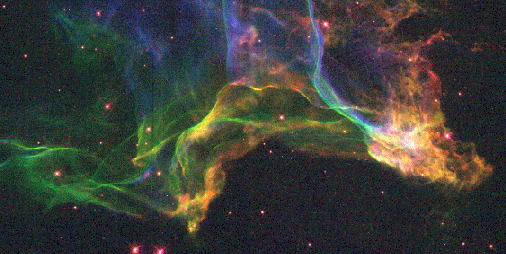
The Cygnus Loop - July 26th, 1996.
"15,000 years ago, a star in the constellation of Cygnus exploded - the shockwave from this supernova explosion is still expanding into interstellar space! The collision of this fast moving wall of gas with a stationary cloud has heated it, causing it to glow in visible as well as high energy radiation, producing the nebula known as the Cygnus Loop (NGC 6960/95). The nebula is located about 2500 light years away. The colours used here indicate emission from different kinds of atoms excited by the shock; oxygen-blue, sulfur-red, and hydrogen-green. This picture was taken with the Wide Field and Planetary Camera 2 onboard the Hubble Space Telescope."
122 notes
·
View notes
Text
The Western Veil Nebula
The Veil Nebula is interstellar debris from a very large star that violently exploded as a supernova about 15,000 years ago. This photo captures the leading shockwave as it continues to expand.
Astronomers call this Supernova Remnant the “Cygnus Loop”, because it is generally circular and viewed in the constellation of Cygnus the Swan. It is nearby at only 2,400 light years, and situated right in our own galactic spiral arm, making our image very crowded with nearby stars.
In this photo, we are looking at the outer edge of the Cygnus Loop debris field that appears facing towards the west. Note the colours: red is hydrogen, blue suggests oxygen, and sulfur is green.
A “Supernova” explosion occurs when an older star depletes fuel and begins to falter at generating a strong stellar wind. As the outward-push falters, gravity causes the aging star to catastrophically implode as a supernova. Indeed, the colours of blue and green suggest the presence of heavier elements, oxygen and sulphur, as formed in the core of older stars.

I photographed the Western Veil Nebula from my garden in Strasbourg France on a single night in August 2024. This is an ensemble of 80 photos, where each was a 3 minute exposure (4 hours of Astrophotography).
More information:
#astrophotography#astronomy#astrophotographie#astrophotographiefrance#astronomie#astronomiefrance#nebulae#veil nebula#veilnebula#Cygnus loop#nebula#strasbourg#cygnus#supernova remnant#supernova
53 notes
·
View notes
Photo

Pickering’s Triangle, part of the Veil Nebula // Alexandre EGON
#astronomy#astrophotography#nebula#emission nebula#supernova remnant#pickering's triangle#veil nebula#cygnus loop#cygnus
253 notes
·
View notes
Text

A quick and (very) dirty mosaic of the H alpha photos I had already taken for the three major components of the Cygnus loop.
I wanted to have an idea of what a future mosaic of this target could look like (probably won't be able to do better than that before the end of the year or next summer unfortunately)
Thought I could post it here while I finish processing newer photos.
22 notes
·
View notes
Text

Ic 1805 - The Heart Nebula
Photographer David Joyce - Space From My Backyard: Pictures I Took With A Telescope

M51 - The Whirlpool Galaxy
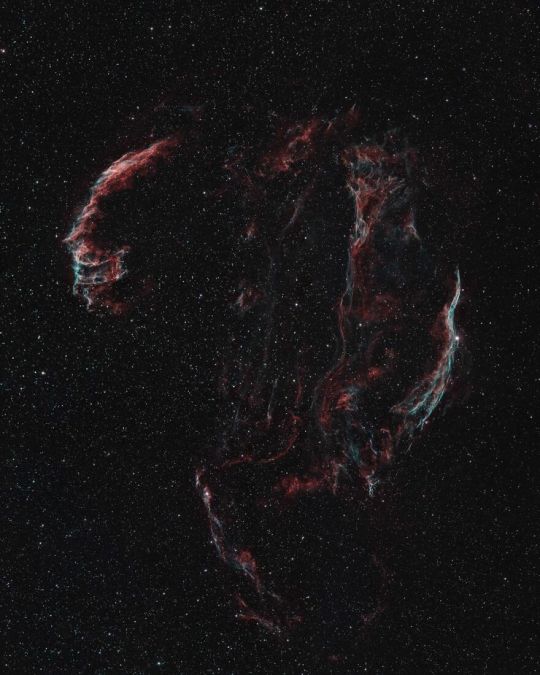
The Cygnus Loop - A 4

M81 - Bode’s Galaxy

Ngc2244 - The Skull Nebula/Rosette Nebula
#david joyce#photographer#astronomy#space#heart nebula#telescope#nebula#whirlpool galaxy#galaxy#cygnus loop#bode's galaxy#skull nebula#rosette nebula#nature
78 notes
·
View notes
Text
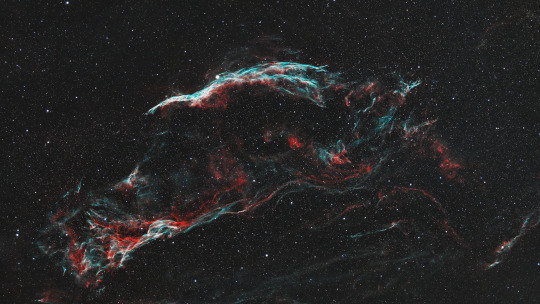
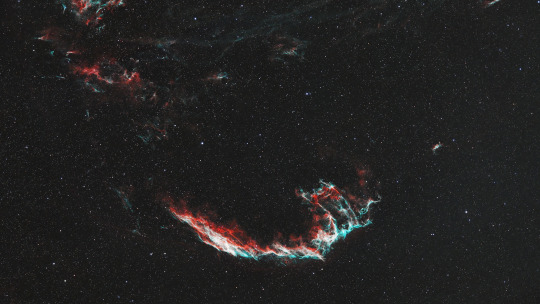

Finished 2 panel mosaic of the Cygnus Loop Supernova Remnant (SH 2-103) Data in H-alpha with RGB (reduced) stars)
#my photography#astrophotography#space photography#veil nebula#eastern veil nebula#western veil nebula#cygnus loop#SH 2-103#NGC 6960#NGC 6992#H-alpha data
11 notes
·
View notes
Text
But You Know He Never Actually Said That, Right?

Cygnus Loop, as taken by the Hubble Telescope, released 1993.
Written for @loginceweek2023, Day 7: Importance Rating: G - WC: 100
“Will any of this matter?”
Roman frowned down at his husband’s head where it lay on his chest. “Mi amor, what do you mean?”
“Look up,” he said, pointing to the stars that painted the night sky. “Some of those stars are already gone. No-one has noticed yet.”
Roman looked up. Then he smiled. “You’re right. Yet their light lives on.” He stroked Logan’s cheek. “They’re like you, mi amor,” Roman whispered. “Their importance outlived them by billions and billions of years.”
A smile grew on Logan’s face. “Excellent Cosmos reference, my Prince.”
“And billions,” Roman laughed.
“Billions,” Logan whispered.
#loginceweek2023#logince#ts logan#ts roman#importance#billions and billions and billions#carl sagan#Cygnus Loop#drabble#ts fanfic
19 notes
·
View notes
Text

14 hours of the Veil Nebula from my yard. Captured on my Canon 90D EOS DSLR at 135mm.
#my astrophotography#veil nebula#cygnus loop#nebula#nebulae#supernova remnant#supernova#space#astronomy
2 notes
·
View notes
Photo

Cygnus Loop © George Chappel
#space#nasa#cygnus#astrophotography#stars#galaxy#night sky#planet#astronomy#planets#nebula#solar system#universe#cygnus loop#cosmos
569 notes
·
View notes
Text

Rampaging Fronts of the Veil Nebula - March 7th, 1996.
"A supernova explosion of a high-mass star results in fast moving blast waves. At the front of the waves shown above, ionised gas in the Veil Supernova Remnant rushes out from the explosion, sweeps up material, and breaks up many atoms into constituent ions and electrons. Observations with the Hubble Space Telescope in 1993 indicate that the blue shock wave was catapulted away from the stellar explosion after the red shock wave, and had yet to catch up to it in some regions. The Veil supernova remnant's has a very large angular size - six times the diameter of the full Moon - and different parts of it are known as the "Cygnus Loop" and catalog numbers NGC 6960, NGC 6979, NGC 6992, and NGC 6995."
#nasa#space#cosmos#universe#astronomy#astrophysics#astrophotography#veil nebula#supernova remnant#cygnus loop
117 notes
·
View notes
Text


me seeing cygnus returning in in your eyes vs watching the map and realizing that my perception of how he and leda met/their relationship and evolution was WAY OFF from what i had in my head and i will have to rework a lot of their dynamic in future fics and stuff
#also it contradicts already existing lore? but that’s a convo for another day#i do rlly like the map it just threw me for a loop#anyway HAPPY JD25 DAY WOOOO!!!!#just dance#just dance 2025#jd cygnus#jd night swan#jd leda#star says
32 notes
·
View notes
Text
our beautiful, and forever mysterious, universe ♥
Though a doomed star exploded some 20,000 years ago, its tattered remnants continue racing into space at breakneck speeds—and the Hubble Space Telescope has caught the action.
The nebula, called the Cygnus Loop, forms a bubble-like shape that is about 120 light-years in diameter. The distance to its center is approximately 2,600 light-years. The entire nebula has a width of six full Moons as seen on the sky.
"Hubble is the only way that we can actually watch what's happening at the edge of the bubble with such clarity," said Ravi Sankrit, an astronomer at the Space Telescope Science Institute in Baltimore, Maryland.
"The Hubble images are spectacular when you look at them in detail. They're telling us about the density differences encountered by the supernova shocks as they propagate through space, and the turbulence in the regions behind these shocks."
The Cygnus Loop was discovered in 1784 by William Herschel, using a simple 18-inch reflecting telescope. He could have never imagined that a little over two centuries later we'd have a telescope powerful enough to zoom in on a very tiny slice of the nebula for this spectacular view.
Credit: Video - NASA, ESA, STScI; Acknowledgment - NSF's NOIRLab, Akira Fujii, Jeff Hester, Davide De Martin, Travis A. Rector, Ravi Sankrit (STScI), DSS.
#space#astronomy#stsci#science#nasa#hubble#universe#hubble space telescope#nebula#astrophotography#Cygnus loop#astrovideo
528 notes
·
View notes
Text
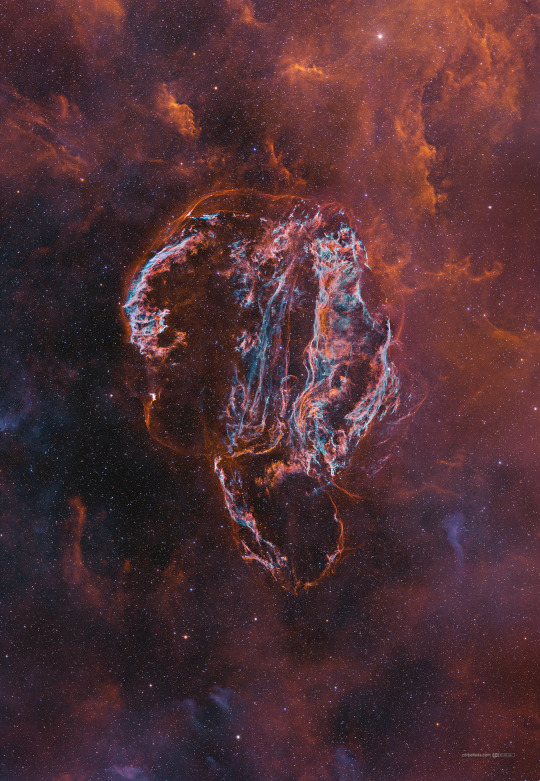
The Cygnus Loop, Sh2-103 // Jose Carballada
#astronomy#astrophotography#nebula#emission nebula#supernova remnant#cygnus loop#veil nebula#western veil nebula#eastern veil nebula#pickering's triangle#Sh2-103#NGC 6960#NGC 6992#NGC 6995#IC 1340#NGC 6974#NGC 6979#cygnus
103 notes
·
View notes
Text

This is an image of a small portion of the Cygnus Loop supernova remnant, taken with the Wide Field and Planetary Camera on NASA's Hubble Space Telescope on April 24, 1991. This research is being presented at the 181st Meeting of the American Astronomical Society in Phoenix, AZ on January 6, 1993, by Dr. Jeff J. Hester, of Arizona State University. The Cygnus Loop marks the edge of a bubble-like, expanding blast wave from a colossal stellar explosion which occurred about 15,000 years ago. The HST image shows the structure behind the shock waves in the Cygnus Loop with unprecedented clarity. This is allowing astronomers, for the first time, to compare directly the actual structure of the shock with theoretical model calculations. Besides supernova remnants, these shock models are important in understanding a wide range of astrophysical phenomena, ranging from winds in newly-formed stars to cataclysmic stellar outbursts. The supernova blast wave is slamming into tenuous clouds of interstellar gas. This collision heats and compresses the gas, causing it to glow. The shock acts as a searchlight by revealing the structure of the interstellar medium. Hubble's detailed image shows the blast wave overrunning dense clumps of gas. Though HST can reveal details about as small as our Solar System, the clumps are still unresolvable. This means that they must be small enough to fit inside our Solar System, making them relatively small structures by interstellar standards. A bluish ribbon of light stretching left to right across the picture might be a knot of gas ejected by the supernoya. This interstellar "bullet," traveling over three million miles per hour (5 million km), is just catching up with the shock front (which has been slowed by plowing into interstellar material). The Cygnus Loop appears as a faint ring of glowing gases about three degrees across (six times the diameter of the Full Moon), located in the northern constellation Cygnus the Swan. The supernova remnant is within the plane of our Milky Way Galaxy and is 2,600 light-years away. Supernova remnants play an important role in stellar evolution by enriching space with heavy elements, and triggering new star formation by compressing interstellar gas. Technical Details: The photo is a combination of separate images taken in three colors. Oxygen atoms (blue) emit light at temperatures of 30,000 to 60,000 degrees Celsius (50,000 to 100,000 degrees Fahrenheit). Hydrogen atoms (green) arise throughout the region of shocked gas. Sulfur atoms (red) form when the gas cools to around 10,000 degrees Celsius (18,000 degrees Fahrenheit).
Source: The Cygnus Loop Supernova Remnant
15 notes
·
View notes
Photo
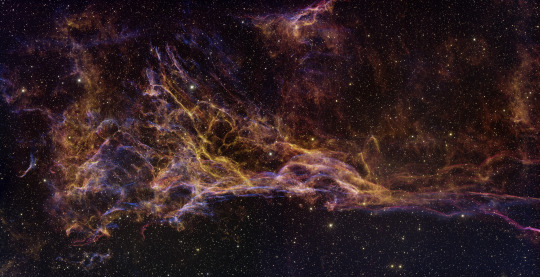
Pickering's Triangle image taken with the Mayall 4-meter Telescope
A wide-field image of Pickering's Triangle taken with the U.S. National Science Foundation's Mayall 4-meter Telescope at Kitt Peak National Observatory. Pickering's Triangle is part of the Cygnus Loop supernova remnant.
Credit: T.A. Rector/University of Alaska Anchorage, H. Schweiker/WIYN and NOIRLab/NSF/AURA (Available under Creative Commons Attribution 4.0 International)
#t a rector#university of alaska anchorage#h schweider#wiyn#noirlab#national science foundation-ocean observatory initiative#aura#pickering's triangle#astronomy#space#mayall 4-meter telescope#cygnus loop supernova#nature
31 notes
·
View notes